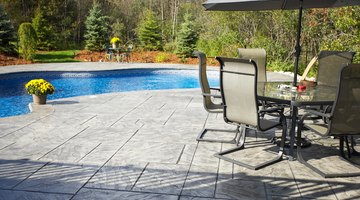How to Resurface a Concrete Patio With Rubber Paint
Rubber paint, or liquid rubber, is a thick, durable, waterproof paint that dries to a smooth finish. Rubber paint is used to paint white walls on tires and often to paint the bottom of boats. It makes almost any surface extremely waterproof.

Using rubber paint on a concrete patio will help to seal any cracks in the concrete, making it very waterproof. The patio will also be easier to clean because the paint will smooth out the rough texture of the concrete and provide an even surface. Hosing or sweeping off the patio will be considerably easier with a coat of rubber paint.
Things You Will Need
- Broom
- Wire brush
- Rubber filler
- Rubber paint
- Paintbrush or roller
- Seam tape
-
Sweep the patio to remove all dust and debris. Set your garden hose nozzle on the highest pressure setting and hose down the patio to remove any dirt and debris not removed with the broom. Use a scrub brush to remove any harder-to-remove substances. Allow the patio to dry completely.
-
Remove loose or peeling paint with a wire brush. Brush firmly across the paint until the surface is smooth. Use medium grit sandpaper, if necessary, to create a smooth finish on the concrete patio. Wipe away debris and sanding dust with a damp rag.
-
Fill any cracks in the concrete with rubber filler. Most companies that sell rubber paint sell a thicker version of the paint to use as a filler for cracks. Apply the filler with a putty knife, smooth the top until it's flush with the rest of the patio. Allow the filler to dry completely. Sand any rough edges if necessary.
-
Use seam tape to bridge any areas where different surfaces meet, such as wood to concrete or masonry to concrete. Smooth the seam tape over the gap and press firmly to adhere.
-
Paint the concrete patio using rubber paint. According to Ames Research Laboratories, rubber paint should be applied thickly, about 1 gallon per 100 square feet, or about the thickness of a dime. Apply a second coat after the first coat is dry to the touch.
-
Allow three to four days for the rubber paint to fully cure. Do not allow foot traffic on the patio until the paint is completely dry.
Tip
It is best to apply rubber paint in dry conditions. Make sure that it is a clear day and there is no immediate rain in the forecast before applying rubber paint to your patio.
The Drip Cap
- Rubber paint, or liquid rubber, is a thick, durable, waterproof paint that dries to a smooth finish.
- Using rubber paint on a concrete patio will help to seal any cracks in the concrete, making it very waterproof.
- Wipe away debris and sanding dust with a damp rag.
- Most companies that sell rubber paint sell a thicker version of the paint to use as a filler for cracks.
- Allow the filler to dry completely.
- According to Ames Research Laboratories, rubber paint should be applied thickly, about 1 gallon per 100 square feet, or about the thickness of a dime.
References
Writer Bio
Lisa East Hunter is a consultant and freelance writer in Phoenix. Her background in marketing and technology led her to explore all avenues of writing. She is currently dividing her time between freelance writing and her consulting business. Hunter has a Bachelor of Science in management information systems and marketing.
Photo Credits
- Jupiterimages/Photos.com/Getty Images
- Jupiterimages/Photos.com/Getty Images
More Articles



